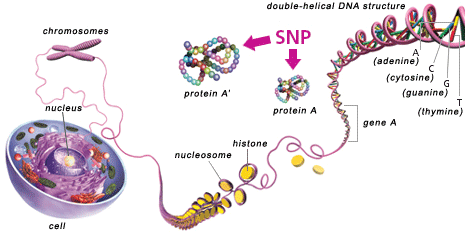Home>Genomic Terms
Glossary
Genomic Terms
- Genetic polymorphism
- Genetic information is encoded by the sequence of bases that make up DNA. The genetic information includes regions that vary between different individuals and these individual sequence variations are called genetic polymorphisms. There are various different types of genetic polymorphisms, but those that involve variation in a single nucleotide are called single nucleotide polymorphisms (SNPs).
The relationship between genes and disease is rapidly becoming clear. As well as previously known conditions caused by an abnormality in a single gene, we now know that genetic factors are involved in common lifestyle-related diseases. It is thought that, instead of gene "abnormalities", the genetic factors implicated in lifestyle-related and other diseases involve a complex relationship between several SNPs that vary between individuals.
- SNP
- SNPs are single nucleotide variations that differ between individuals. There is thought to be one SNP for every 500-1000 bases and 3-5 million SNPs in the entire human genome, with SNPs in around 500,000 gene regions. SNPs found within a gene may cause variation in the timing, amount, or function of the protein produced by that gene.
- Haplotype block
- Genomes recombine when they are passed on from parent to child, but SNPs in adjacent locations are inherited as a set called a haplotype block. It is possible to identify other SNP types simply by analyzing a limited number of SNPs (tag SNPs) in a haplotype block, without having to analyze all SNPs individually. The HapMap will define what types of haplotype blocks are located where on the genome. Once completed, the HapMap should enable scientists to efficiently and comprehensively identify genes associated with disease susceptibility, drug responsiveness, or drug side effects.
- The Human genome
- The genome is equivalent to the blueprint of life. The human genome consists of 23 chromosome pairs (a total of 46 chromosomes), with one set (23 chromosomes) inherited from our mother and one set from our father.
- DNA
- DNA is the substance that encodes the genetic information. DNA is made up of strands of four types of bases: A (adenine), T (thymine), G (guanine), and C (cytosine). The bases link into pairs, forming the double-helical DNA structure. The genetic information is determined by the order of the bases in the strands. The human genome contains around 3 billion base pairs.
- Gene
- A gene corresponds to a portion of the genome. It is a functional unit that determines what protein is produced at what time, in which cell type, and in which quantities. Current estimates indicate that there are about 30,000 genes in the human genome.



